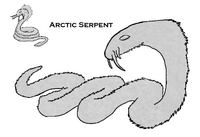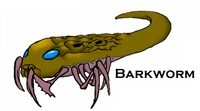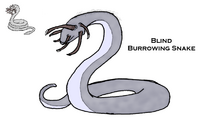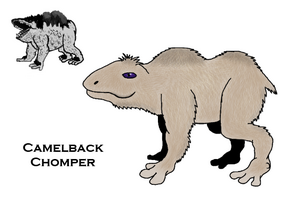Triumph of Spring (Fortune: Evolution Game): Difference between revisions
1d4chan>FortuneBro |
1d4chan>FortuneBro (added image) |
||
| Line 45: | Line 45: | ||
(Picture Complete) | (Picture Complete) | ||
===Chomper, Bull=== | ===Chomper, Bull=== | ||
[[File:BullChomper_00.png|200px|thumb|Bull Chomper]] | |||
'''Bull Chompers''' are terrestrial herbivorous repto-mammals that live in the high tops of mountains and other alpine environments. As such, they are only found in the Mountains region on Fortune. | '''Bull Chompers''' are terrestrial herbivorous repto-mammals that live in the high tops of mountains and other alpine environments. As such, they are only found in the Mountains region on Fortune. | ||
Revision as of 11:11, 12 May 2012
The "Triumph of Spring" is the name given to the fifth part of the Fortune: Evolution Game. It is set after the end of the Ice Age that comprised parts 3 & 4. The name was first used here on 1d4chan, and was discovered by the players in the midst of Discussion Thread 2. Triumph of Spring introduced a new map, with a variety of environments and a reworked continent (shifted by continental drift etc.). It also introduced a new landmass, called Volcano Island, formed as a result of the massive eruption that led to the end of the Ice Age.
This article/entry is for additional details and fluff concerning the starting organisms available at the very start of the thread, along with behind the scenes information about the creation and development of the species by FortuneHost and the players.
Animals
Aquabeast

The Aquabeast is a carnivorous aquatic repto-mammal that lives in cold saltwater habitats, usually inhabiting the mid-range to deep ocean depths. It makes its home in the Continental Shelf and the North Sea Regions.
The Aquabeast is about the size of a whale shark, roaming the mid to near-surface depths of the ocean. While most of its body is covered in dense bony armor, its underbelly is adorned with slick blue hairs, stuck close together, similar to a penguin's feathers. Being such a large beast, this creature's digestive system is wonderfully efficient, even the bones of prey are digested. The calcium present in these goes to the upkeep/growth of the Aquabeast's impressive armor (which, is actually a modified second skeleton). While the Aquabeast is only moderately fast, it does have the advantage of a long tongue, one that can extend it body length away. In this regard, the Aquabeast has changed little from its Spineback predecessor, it remains an ambush predator, relying on a single decisive strike to grab prey before it has a chance to react.
Arctic Serpent

The Arctic Serpent is an arboreal mammal whose main diet consists of insects and prefers forests with a cold to temperate climate. They are found in the region known as the Northern Wildwood.
The Arctic Serpent is one of Fortune's few mammals, giving live birth and with lactating females. While their ancestors burrowed underground to escape the cold, since the meltdown, they have returned to their arboreal routs, hanging in the boughs of trees in groups of up to a dozen. Here they eat the many insects that are (suprisingly) common in Fortune's colder regions. The Arctic Serpent is probably about the size of a large dog, like a Great Dane.
Barkworm

Barkworms are omnivorous insectoids that make their homes inside burrows carved out of tree-trunks. They are found wherever there are trees, and so are most common in the regions of the Northern Wildwood and the Equatorial Jungles.
Barkworms are a creatures that has changed very little in millions of years. They inhabit the inside of trees, helping to clean out dead bark and rotten roots, the way cleaner fish pick dead skin off larger fish on Earth. The Barkworms will also not hesitate to eat deceased animals either, provided they are not far from the creature's burrows (such burrows are either bored into the tree itself or are in the dirt beneath its roots).
Barkworms are about the size of a human hand.
Beach Crab
Blind Burrowing Snake
Blind Burrowing Snakes are subterranean mammals with an omnivorous diet (roots as well as insects). They are found in the following regions: Meadowed Plains, Equatorial Jungles, & the Northern Wildwood.

Due to a random mutation deep in its past, the Blind Burrowing Snake lost its eyes, to be replaced with short digging arms, each possesed of a single thick "fingernail"-like structure.
These creatures give birth to live young, about 2-4, and upon emergence, sniff out their mothers teats, and survive on a diet of milk until about 3 months, after which their mother weans them onto insects and roots.
The snakes live in small family groups, consisting of around 10-20 individuals and live in an extensive warren, not unlike Earth's prarie dogs.
In terms of size, Blind Burrowing Snakes are around the length and thickness of a human arm.
Bloat, Land
Bloat, Sea
Bloat Whale
(Picture Complete)
Chomper, Bull

Bull Chompers are terrestrial herbivorous repto-mammals that live in the high tops of mountains and other alpine environments. As such, they are only found in the Mountains region on Fortune.
Gorilla-sized mountain herbivores, the Bull Chomper is an offshoot of the "Thumbed Chomper". Developing in the mountains, the Bull Chompers fur became thicker, shaggier, and turned a deep black. This colour change served to absorb more of what little heat it recieved high in its alpine home. Surprisingly, it also serves as camoflauge. Bull Chompers will bury their bodies in the snow, and look for all the world (to hungry predators at least) like a rock formation jutting out of the snow.
Bulls Chompers travel in herds of about 5-10, a single alpha male and his "harem" and children, like lion prides on Earth. An alpha male possesses a bright red "mohawk" a symbol of his status, but one that only develops once a male has a herd of his own (similar to the change that turns male gorillas into silverbacks).
Most young males will wander alone, never to be seen save during mating season. It is during this time that the alphas are formally challenged (with headbutting reminiscent of musk oxen) , though sometimes while fighting, other males will sneak in and mate with the females, who have no qualms 'cheating' on their alpha. Any products of these unions are allowed to hatch, but as soon as the young can walk, the alpha will chase it from the herd. Bull Chompers, like most of Fortune (save for the Arctic Serpents & Blind Burrowing Snakes) lays clutches of eggs. One hallmark of the Chomper species is that they lay only a few eggs (one or two at a time) and then raise them to adulthood.
The Bull Chomper possesses thick calluses on the ends of its knuckles, these serve as dextrous "hooves" that assist the creature in staying steady on high mountaintops much like Earth mountain goats.
Chomper, Camleback

Camelback Chompers are terrestrial repto-mammals found in temperate to dry plains & steppes as well as deserts. They subsist on a herbivorous diet and are found in the regions of the Great Northern Savannah, the Desert, and the Meadowed Plains.
Camelback Chompers are horse-sized nomadic herbivores that are built to survive harsh, dry conditions. They mainly do this through the use of the fat cells stored in their "hump", allowing for them to, in emergency or drought, to survive for about 3 weeks without food, noticeably shrinking their humps. Should this happen, the Camelback will gorge at the next opportunity, attempting to replace the lost storage. Their bodies are also adept at storing water, including thick jowls (like a Bloodhounds) that trap saliva in the cheeks, allowing it to be reused rather than lost via drool/evaporation.
Camelbacks travel in herds of anwhere from a dozen to nearly a hundred animals, grazing and lazily migrating across their habitats. These herds are the primary family unit, and while hatchlings are cared for mainly by their biological parents, Camelbacks often have a group of older females past breeding age that act as a sort of "daycare" for the herd as a whole (similar to meerkats on Earth). Camelbacks even have the curious practice of "adoption", where, if the parents of a baby or juvenile Camelback perish, a mated pair without a child of their own will take the youngster in. At times this is done even if the mated pair already has a child, and other times one of the non-breeding "daycare" females will take the orphan in.
(Chomper) Smiler
(Picture & Description Complete)
Demolisher (Spineback)
Featherscale
(Picture & Description Complete)
Grey Wretch
(Picture & Description Complete)
Ice Bug
(Picture Complete)
Ice Ray
(Picture & Description Complete)
Mosquito Fly
Proboscis Scorpion
(Picture Complete)
Raveshark, Abyssal (Ravedragon)
(Picture Complete)
Raveshark, Common (Midnight)
(Picture Complete)
Raveshark, Shadow
(Picture Complete)
Rock Leech
(Picture Complete)
(Rock Leech) Common Stinger
(Picture Complete)
(Rock Leech) Parasitic Stinger
(Picture Complete)
Sail Flipper (Windsail Dolphin)
(Picture Complete)
Saltback Frog
(Picture & Description Complete)
Shogun Walrus
(Picture & Description Complete)
Skullroot
(Picture Complete)
Skullroot, Deathmasque
(Picture Complete)
Snow Beetle
(Picture Complete)
Snow Crab
(Picture Complete)
Snow Tick
(Picture Complete)
Spitter Crab
(Picture Complete)
Tentacle-Eating Leech
(Picture Complete)
Webspinner (Silt Spinner)
(Picture Complete)
Plants
Alpine Herb
(Picture Complete)
Asparagus Tree, Common
(Picture Complete)
Asparagus Tree, Steppes
(Picture Complete)
Bloodsucker Lichen
Bluegrass, Common
(Picture Complete)
Bluegrass, Dwarf
(Picture Complete)
Boom Ginger
Ice Shrub
(Picture Complete)
Mud Shrub
(Picture Complete)
Salt Cactus
(Picture Complete)
Salt Ginger
(Picture Complete)
Snow Shrub
(Picture Complete)
Spineroot
(Picture Complete)
Vampire Lily, Common
(Picture Complete)
Vampire Lily, Flowering
(Picture Complete)
Vampire Lily, Giant
(Picture Complete)
Water Berry Groves
(Picture Complete)